Haryana Board Class 10 Biology Solutions For Chapter 2 How Do Organisms Reproduce? Multiple Choice Questions And Answers
Question 1. The image shows the model of a family of dogs.

It can be observed that the offspring is similar to the parent but not identical. What is the likely reason for this?
- Variation in the genetic material
- Fast multiplication of body cells
- Asexual mode of reproduction
- Effect of environment on the offspring.
Answer: 1. Variation in the genetic material
Question 2. A population of thermophilic archaebacteria are generally found in hot springs. Any change to the temperature of the water affects the survival of the archaeabacteria. If the temperature of hot springs gets reduced, change in which component can allow survival of few members of these archaeabacteria?
- Cell wall
- Cytoplasm
- DNA
- Ribosomes
Answer: 3. DNA
Question 3. The image shows the process of division in plasmodium.

What can be concluded about the division in plasmodium?
- The cyst divides repeatedly to form many daughter cells.
- The cell divides multiple times giving rise to many daughter cells.
- The nucleus divides repeatedly inside the cell to form new daughter cells.
- The cyst enlarges in size and then bursts producing many new daughter cells.
Answer: 2. The cell divides multiple times giving rise to many daughter cells.
Question 4. The image shows the process of binary fission in amoeba.
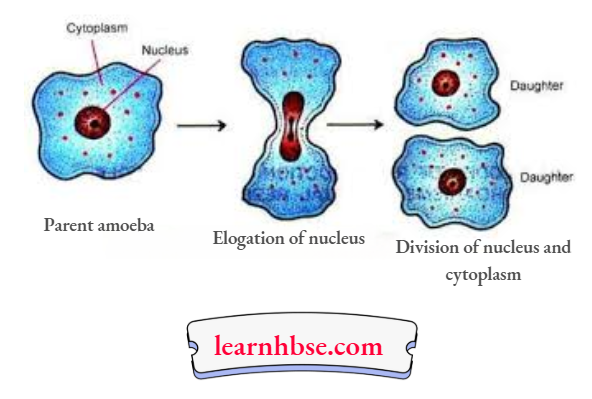
Which option correctly predicts about the daughter cells?
- The parent cell will lead to the formation of four daughter cells of equal sizes.
- The parent cell will lead to the formation of two daughter cells of equal sizes.
- The parent cell will lead to the formation of four daughter cells of different sizes.
- The parent cell will lead to the formation of two daughter cells of different sizes.
Answer: 2. The Parent cell will lead to the formation of two daughter cells of equal sizes.
Question 5. The image shows the formation of spores in Rhizopus.
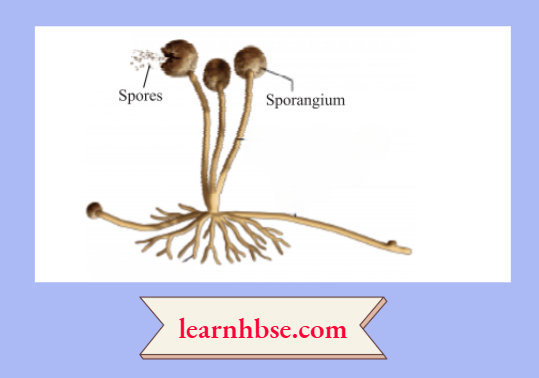
How spores develop into Rhizopus?
- Spores divide and grow into new individual
- Spores combine with other spores and grow
- Spores enlarge in size for the growth of new individual
- Spores land on other organisms and increase with their growth in size
Answer: 1. Spores divide and grow into new individual
Question 6. The image shows the division in Spirogyra
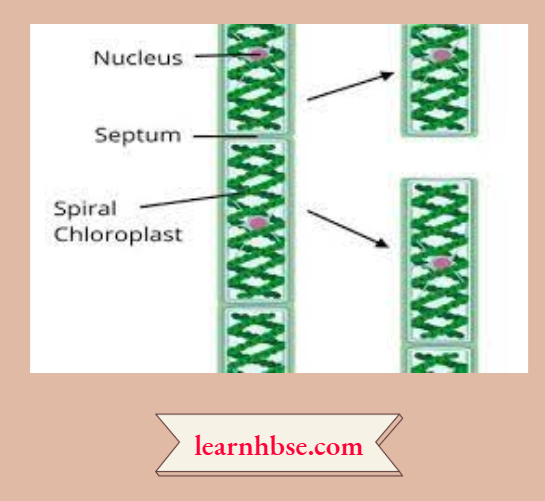
What can be concluded about the Spirogyra from this division?
- It is a multicellular organism gives rise to two new equal sized individuals.
- It is a unicellular organism that gives rise to two new equal sized individuals.
- It is a unicellular organism that breaks into pieces that grows into new individuals.
- It is a multicellular organism that breaks into pieces that grows into new individuals.
Answer: 4. It is a multicellular organism that breaks into pieces that grows into new individuals.
Question 7. A student takes a planaria in the lab and cuts into three parts as shown.
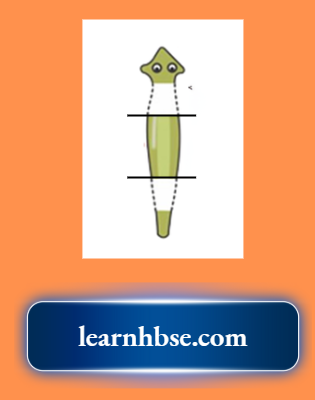
What will likely happen?
- The cells around the cut start to divide to form lost part
- The cells around the cut enlarge to take the shape of lost part
- The cells around the cut start to divide to form a complete organism
- The cells around the cut attracts other planarians to fuse with the separated part.
Answer: 3. The cells around the cut start to divide to form a complete organism
Question 8. A student observes the process of regeneration in Planaria.
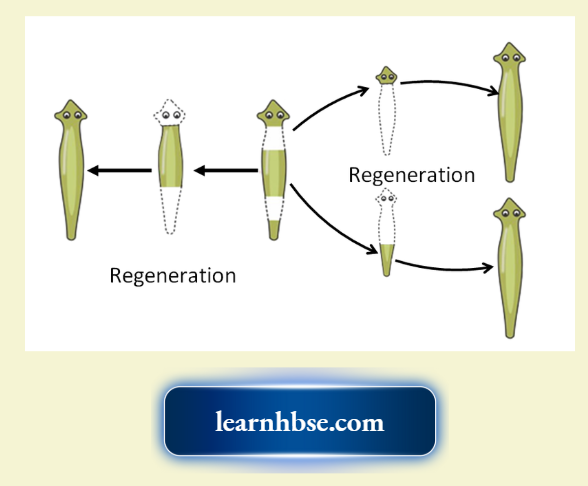
The student claimed that the newly formed planarians have identical genome. Which statement support the claim?
- It is a single celled organism
- All planarians share the same genome.
- Division in Planaria involves a single parent.
- Planaria divides only under unfavourable condition
Answer: 3. Division in Planaria involves a single parent.
Question 9. The image shows a bud developing on a Hydra.
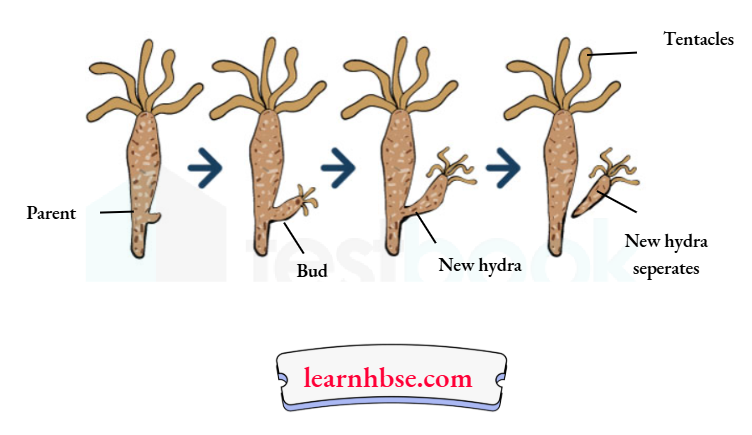
How does the bud develop in the Hydra?
- Bud develops due to separation of body parts of hydra
- Bud develops due to repetitive cell division at a specific site
- Bud develops due to change in the environmental conditions
- Develops due to attachment of another hydra at a specific site
Answer: 2. Bud develops due to repetitive cell division at a specific site
Question 10. The model shows the process of budding in Hydra.
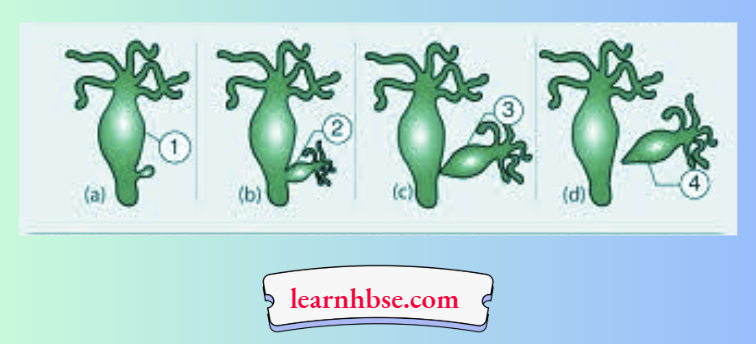
What is the likely purpose of this division in Hydra?
- To increase the body size
- To recover lost body parts
- To induce variation in body
- To develop new independent individual
Answer: 4. To develop new independent individual
Question 11. The image shows the process of vegetative propagation in a plant
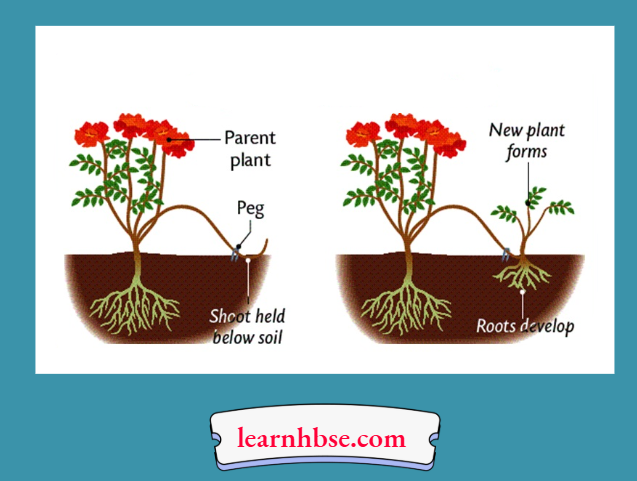
The shoot of the parent plant is pushed below the soil that results in growth of a new plant. What is the advantage of this process?
- This results in plant of different flowers
- This helps grow plants without adding extra manure
- This eliminates the need of producing plant using seeds
- This allows growth of plants with new genetic composition
Answer: 3. This eliminates the need of producing plant using seeds
Question 12. The image shows the production of a new sugarcane from an existing sugarcane plant.
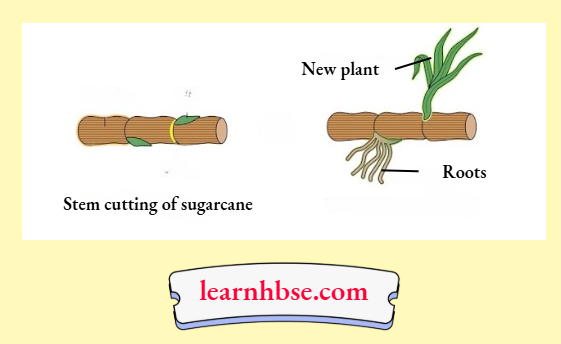
The method is called vegetative propagation. Which option supports the name of this process?
- It is a sexual method of producing new plants.
- It is an asexual method of producing new plants.
- It does not require a parent plant for reproduction.
- It involves fusion two parts of a single parent for reproduction.
Answer: 2. It is an asexual method of producing new plants.
Question 13. The image shows the different parts of a flower.
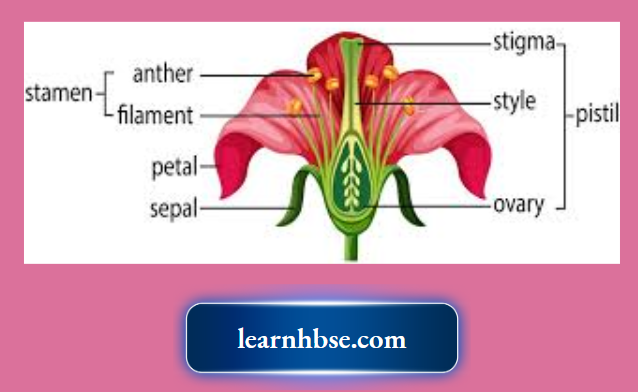
Which part of the pistil is responsible for receiving pollen from stamen in order to perform reproduction?
- Anther
- Ovary
- Petal
- Stigma
Answer: 4. Stigma
Question 14. The image shows the structure of a flower.

Which process will likely be disturbed or not occur, if labelled part is removed from the flower?
- Formation of fruit
- Transport of pollen
- Formation of pollen
- Development of pollen tube
Answer: 1. Formation of fruit
Question 15. Which option correctly lists the changes that occur in males during puberty?

Answer: 1. 
Question 16. The table shows the changes that occur in girls during puberty.
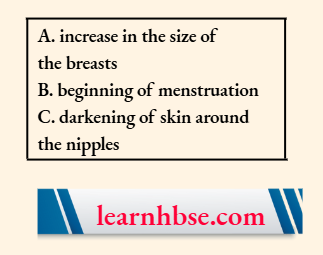
What is the likely significance of these changes?
- Aging of the body
- Sexual maturation
- Production of germ cells
- Abnormal division of the cells
- Answer: 2. Sexual maturation
Question 17. The image shows the male reproductive system.

Which option correctly shows the path that the sperms take when they are released from the body?
- Testis → ureter → urethra → penis
- Testis → vas deferens → ureter → penis
- Testis → ureter → vas deferens → penis
- Testis → vas deferens → urethra -→ penis
Answer: 4. Testis → vas deferens → urethra → penis
Question 18. The image shows the male reproductive system outside abdominal cavity.
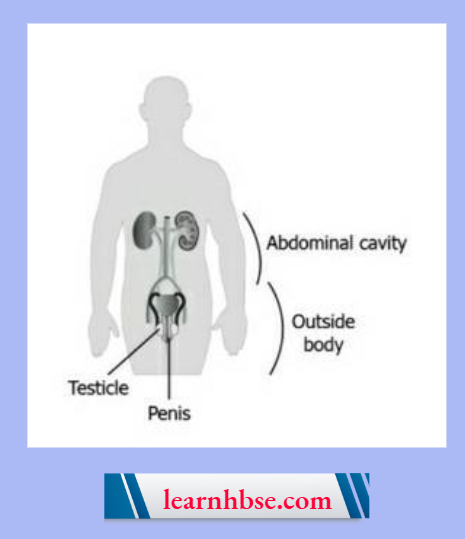
What will likely happen if testes are located inside the abdominal cavity?
- Delayed puberty
- Sperm formation
- Increase in body temperature
- Change in genetic composition of sperms
Answer: 1. Delayed puberty
Question 19. The image shows the reproductive organ in females
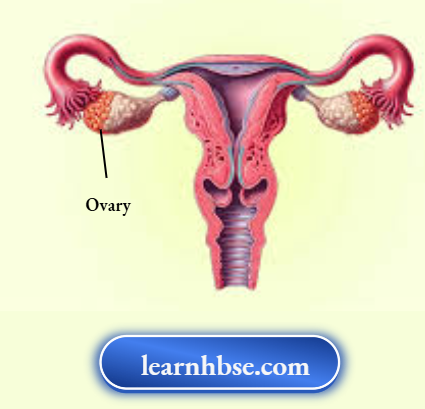
Which event will likely occur in the ovaries of females after attaining puberty?
- Fertilisation
- Synthesis of eggs
- Production of eggs
- Growth and development of embryo
Answer: 3. Production of eggs
Question 20. The image shows the female reproductive system.

Which event will be likely affected, if a female’s uterus is implanted with intrauterine device?
- Release of eggs
- Entering of sperms
- Maturation of eggs
- Implantation of embryo
Answer: 4. Implantation of embryo
Question 21. The table lists some changes that occur inside the female body after fertilization of egg with sperm.
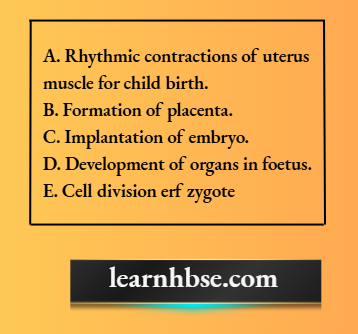
Which option correctly sequences these events?
- C→B E A→D
- E→C→D→B→A
- E→C→B →D→A
- C→E→A→B→D
Answer: 3. E→C→B→D→A
Question 22. After a female attains puberty, the body undergoes many changes for maturation. Which event will likely happen in the female body when there is no fertilization of egg?
- Disintegration of uterine wall
- Development of egg into zygote
- Increase in the production of eggs in the ovaries
- Of a mature egg into an immature egg
Answer: 1. Disintegration of uterine wall
Question 23. Which contraceptive can be used to prevent the entry of sperm inside the female reproductive organ?
- Inserting copper-t inside the uterus
- Wearing condoms on the penis
- Consuming oral pills containing hormones
- Undergoing surgery for blocking fallopian tube
Answer: 2. Wearing condoms on the penis
Question 24. The image shows a surgical method in females to prevent pregnancy.
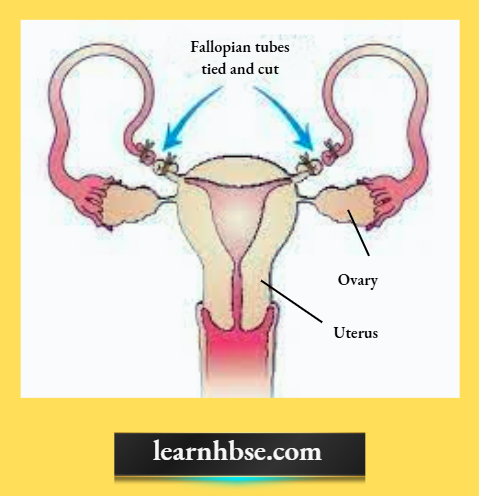
Which event will be likely prevented from this method?
- Maturation of eggs
- Production of eggs
- Entry of eggs into the uterus
- Entry of sperm into the uterus
Answer: 3. Entry of eggs into the uterus
Chapter 2 How Do Organisms Reproduce Very Short Questions And Answers
Question 1. What is the main advantage of sexual reproduction over asexual reproduction?
Answer: Sexual reproduction provides diversity in the genetic makeup of the offspring. This is due to the combination of genes from two different individuals.
Question 2. Why is DNA copying an essential part of the process of reproduction?
Answer: DNA copying is essential for inheritance of features from parents to the next generation.
Question 3. How does the embryo get nourishment inside the mother’s body?
Answer: The embryo gets nourishment through the placenta.
Question 4. Why does bread mould grow profusely on a moist slice of bread rather than on a dry slice of bread?
Answer: The spores of bread mould need favourable conditions like moist surface to germinate. Since, moistened bread slice offers both moisture and nutrients to the bread mould, hence it grows profusely. Dry slice of bread offers nutrients, but not moisture hence, hyphae fail to grow.
Question 5. Why cannot fertilisation take place in flowers if pollination does not occur?
Answer: In a flower fertilization requires both male and female gametes. If pollination does not occur, male gamete is not available hence fertilization cannot take place.
Question 6. What is the basic difference between male and female germ cell?
Answer: The male germ cell is motile while the female germ cell is non-motile.
Question 7. State the condition necessary for germination of pollen grain.
Answer: Pollen grain germinates only if it has fallen on the stigma of the same plant species, or else it decomposes.
Question 8. Which organ of female reproductive system is also known as birth canal?
Answer: Vagina
Question 9. What is the effect of DNA copying which is not perfectly accurate in the reproductive process?
Answer: It results in variations in populations
Question 10. Which artificial propagation method is used to propagate roses?
Answer: Grafting.
Question 11. Specify the first event which occurs in the reproductive system of a human female if egg is fertilised.
Answer: If egg is fertilized, it gets implanted in the uterine lining resulting in pregnancy.
Question 12. Specify the events which occur in the reproductive system of a human female if egg is not fertilised.
Answer: If egg is not fertilized, it is shed out of the body along with blood causing menstruation.
Question 13. In a tobacco plant, the male gametes have 24 chromosomes. What is the number of chromosomes in the female gamete? What is the number of chromosomes in the zygote?
Answer: Number of chromosomes in female gamete is 24. Number of chromosomes in zygote is 48.
Question 14. Neha took two bread slices and kept them in the following conditions:
- Slice 1 in a dried and dark place
- Slice 2 in moist and dark place
What would she observe in each of the above conditions?
Answer:
- No spores will be formed in Slice 1 due to lack of moisture,
- In Slice 2, fungal hyphae develop due to the presence of favourable condition, i.e, moisture.
Question 15. Kashyap noticed that an organism by mistake was cut into parts. After sometime, both parts developed into new individuals.
- Name the mode of reproduction used by the organism.
- State the type of cells which carry out this process.
Answer:
- Regeneration
- Regenerative cells.
Question 16. Name the site of implantation and development of baby in human female.
Answer: Uterus
Question 17. Mention any two benefits of using barrier method during sexual act.
Answer:
- Protection from sexually transmitted diseases,
- Prevention of pregnancy
Question 18. Trace the path of sperms from where they are produced in human body to the exterior.
Answer: Testes-Epididymis-Vas deferens-Ejaculatory duct-Urinogenital duct-Penis.
Question 19. Why is DNA copying an essential part of the process of reproduction?
Answer: DNA copying is essential for ensuring that exact blue print of body design of parents is inherited by the offsprings
Question 20. Why are asexually reproducing organisms capable of showing hereditary features?
Answer: The asexually reproducing organisms require only single parent, so when they divide the cell itself divide into two bearing no variation in DNA. So there is more chance of hereditary features,
In asexual reproduction, organisms raised are the exact copy of their parents, They exhibit very little variation due to some environmental factors or mutations which are due to sudden changes in genes out of these two factors, only mutations are inheritable.
Question 21. Offspring formed due to sexual reproduction have better chances of survival. Why? Is this statement always true?
Answer: Offspring formed due to sexual reproduction have better chances of survival because Sexual reproduction introduces genetic variation in the offspring which is essential for evolution and survival of the species; Offspring exhibit hybrid vigour which enables them to adapt better to the changing environment; Enhanced traits allow the offspring to be tolerant and survive under adverse conditions.
It is not always true that the offspring formed by sexual reproduction have better chances of survival because during sexual reproduction, there is crossing over and random selection due to which the offspring produced may have traits which are inferior to the parents.
Question 22. Protozoans reproduce by binary fission as well as multiple fission. Which process is better and why? Give your opinion.
Answer: Multiple fission is better than binary fission because it produces several daughter cells inside a protective structure called cyst. This ensures their survival under adverse conditions.
Question 23. List four ways of preventing pregnancy. State two advantages of using such preventive methods.
Answer: Ways of preventing pregnancy: Natural method: The sexual act is avoided from day 10 to day 17 of the menstrual cycle, i.e. during the period ovulation is expected. Barrier methods: The fertilisation of ovum and sperm is prevented with the help of physical devices (condom and diaphragm). Oral contraceptives: Tablets or drugs are taken orally. These contain small doses of hormones which prevent the release of eggs and prevent fertilisation. Intrauterine contraceptive devices: Contraceptive devices such as CopperT rods are placed in the uterus to prevent pregnancy. Two advantages of using preventive methods are:
- These helps in prevention of sexually transmitted diseases such as syphilis, AIDS etc.
- These helps in maintaining control over human population by avoiding the unwanted pregnancies.
Question 24. Basis the understanding of size of the organism and chromosome number, answer the following
questions:
- Do larger organisms have more number of chromosomes/cells?
- More the number of chromosomes/cells greater in the DNA content. Justify.
Answer:
- No, there is no relationship between size of organism and its chromosome number,
- Yes, since the major component of chromosome is DNA, if there are more chromosomes in a cell, the quantity of DNA will also be more.
Question 25. A married woman used a device made of common metal for preventing pregnancy. This device was put into her uterus by some trained medical professional. Unfortunately she got pregnant after two months of insertion of device. She was in shock to learn that her birth control device has failed.
- How does device X prevent pregnancy?
- Why do you think the woman got pregnant even after using device X?
Answer:
- Device X (Copper-T) suppresses fertilizing capacity of sperms and thus, prevents pregnancy,
- Intra-uterine devices can be expelled anytime without the knowledge of the woman. The couple continued active sexual life thinking that their birth control device is still in action.
Question 26. Compare the vegetative propagation in Bryophyllum and money plant.
Answer: Bryophyllum reproduces by the adventitious buds present on the margins of its leaves. Money plant reproduces by stem cutting which can produce the whole plant when placed in moist soil.
Question 27. Sujata’s parents received a proposal for her marriage from a boy living in London. Before everything could get finalised, Sujata asked her parents to ask the boy to get his blood test report.
- Do you think it was right on the part of Sujata to do so?
- Name two STDs along with their causative organism.
Answer:
- Yes, it was right on Sujata’s part to do so because blood reports would indicate whether the person has any disease, any sexually transmitted disease or is free of them,
- Two sexually transmitted diseases are:
- AIDS caused by HIV
- Gonorrhoea caused by Neisseria gonorrhoea
Question 28. Explain how, offspring and parents of organisms reproducing sexually have the same number of chromosomes.
Answer:
The process of cell division called meiosis halves the number of chromosomes present in the cell of an organism. The gametes produced as a result of meiosis, fuse during sexual reproduction and restore the number of chromosomes in the offspring of the individual.
Question 29. What substances pass
- From the maternal to the foetal blood?
- From the foetal to the maternal blood?
Answer:
- Oxygen, nutrients (food and water) pass from maternal to foetal blood,
- Carbon dioxide and other waste substances like nitrogenous waste (urea) pass from foetal to maternal blood.
Question 30. The sperms are tiny bodies that consist of mainly genetic material and a long tail,
- Where are the sperms produced? What is the role of the long tail?
- How are the sperms delivered from the site of their production?
Answer:
- Sperms are produced in seminiferous tubules present in testers of male reproductive system by process known as spermatogenesis, ii. Sperm consists of 2 main parts head and tail, both of which are connected by neck. The long tail also known as flagellum of sperms helps in quick movement or motility of sperms through the female reproductive tract through wave like motion,
- Sperms are delivered from the site of their production by vas deferens, also known as sperm duct to the urethra in order to allow the passage of semen outside the body. Movement of sperm is facilitated by prostatic fluid.
Question 31. If a woman is using Copper-T, will it help in protecting her from sexually transmitted diseases? Why?
Answer:
If a woman is using a copper-T,it will not help in protecting her from sexually transmitted diseases. Copper-T prevents only implantation in the uterus.
Question 32. A potato is cut into a number of small pieces. These potato pieces are placed on wet cotton kept in a tray. After a few days, green shoots and roots appear only from some potatoes and not from all potato pieces. Why?
Answer:
The pieces of potato that bear nodes only can give rise to new plants by producing shoots and roots. But the pieces not bearing nodes cannot produce new plants. Thus, from a whole potato only some pieces that bear nodes give rise to roots and shoots. This is an example of vegetative propagation which is an asexual mode of reproduction in plants.
Question 33. It is a well-known fact that a pregnant woman’s health is the backbone of every family, society and thus nation.
- Which tissue is responsible for providing nutrition from the mother to the growing embryo?
- According to you, what can be the likely measures to maintain a woman’s health during pregnancy?
Answer:
- The placenta is responsible for providing nutrition from the mother to the growing embryo. Exchange of nutrients, oxygen and waste products between the embryo and the mother takes place through the placenta,
- Measures a woman can take to maintain health during pregnancy: Consume a balanced diet; Take food or medicinal supplements as required; Be careful about diet and hygiene; Exercise regularly; Stop bad habits like smoking and drinking alcohol; Take adequate rest.
Question 34.
- What is the role of the seminal vesicles and the prostate gland?
- If a woman is using a copper-T, will it help in protecting her from sexually transmitted disease?
Answer:
- The prostate gland makes the medium of semen alkaline as sperms require an alkaline medium to thrive. The seminal vesicle adds fluid content to the semen,
- No, because the copper-T just hampers the process of implantation of embryo in the uterine wall but not provides protection against sexually transmitted diseases.
Question 35. Write the full form of AIDS. Name the causative agent of AIDS. How is this disease transmitted?
Answer:
‘AIDS’ stands for “Acquired Immuno Deficiency Syndrome”. Its causative agent is Human Immunodeficiency Virus (HIV). It is transmitted from an infected person to a healthy person in the following ways – Through sexual intercourse, if one of the partner is infected; Through contaminated blood transfusion; The virus from infected mother may cross through the placenta and reach the embryo in the womb.
Question 36. How will an organism be benefited if it reproduces through spores?
Answer:
There are several advantages if the organism reproduces by spores: There are large numbers of spores formed from one sporangium; The spores can remain in dormant state till the favourable conditions are available; The spores have thick covering called cyst which helps them to survive in unfavourable conditions; The spores are very light and can spread easily through water, air or through the animals.
Question 37. Mrs. Kumar is pregnant for the last three months and she goes for regular check-up to her doctor. During her last visit, the doctor asked Mrs. Kumar to get an ultrasound done. Both Mr. and Mrs. Kumar went to a radiologist and got the ultrasound done. Once the ultrasound is over, Mr. Kumar asked the doctor whether the baby in the womb is a boy or a girl.
- What should the doctor reply to the couple?
- Is it ethical to determine the sex of a child?
- What should government do to discourage sex determination?
Answer:
- The doctor should not tell the sex of the foetus,
- No, it is not ethical to determine the sex of a child,
- The government should ban the process of sex determination and should punish or fine whosoever does so.
